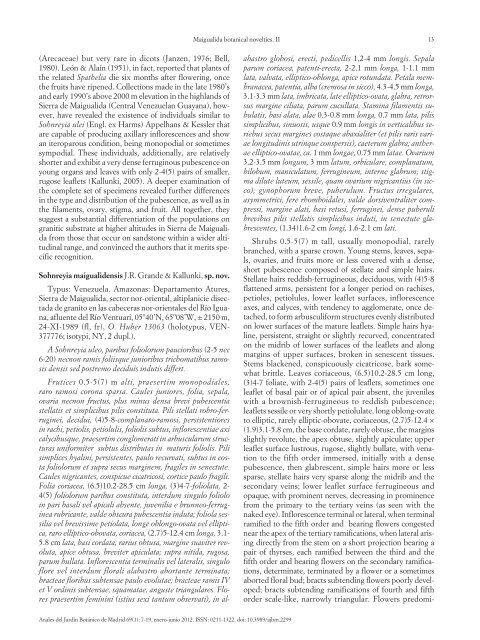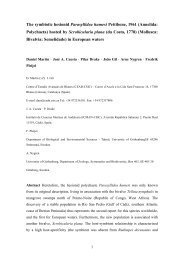Botanical novelties from Sierra de Maigualida, southern ... - CSIC
Botanical novelties from Sierra de Maigualida, southern ... - CSIC
Botanical novelties from Sierra de Maigualida, southern ... - CSIC
Create successful ePaper yourself
Turn your PDF publications into a flip-book with our unique Google optimized e-Paper software.
<strong>Maigualida</strong> botanical <strong>novelties</strong>. II<br />
13<br />
(Arecaceae) but very rare in dicots (Janzen, 1976; Bell,<br />
1980). León & Alaín (1951), in fact, reported that plants of<br />
the related Spathelia die six months after flowering, once<br />
the fruits have ripened. Collections ma<strong>de</strong> in the late 1980’s<br />
and early 1990’s above 2000 m elevation in the highlands of<br />
<strong>Sierra</strong> <strong>de</strong> <strong>Maigualida</strong> (Central Venezuelan Guayana), however,<br />
have revealed the existence of individuals similar to<br />
Sohnreyia ulei (Engl. ex Harms) Appelhans & Kessler that<br />
are capable of producing axillary inflorescences and show<br />
an itero parous condition, being monopodial or sometimes<br />
sympodial. These individuals, additionally, are relatively<br />
shorter and exhibit a very <strong>de</strong>nse ferruginous pubescence on<br />
young organs and leaves with only 2-4(5) pairs of smaller,<br />
rugose leaflets (Kallunki, 2005). A <strong>de</strong>eper examination of<br />
the complete set of specimens revealed further differences<br />
in the type and distribution of the pubescence, as well as in<br />
the filaments, ovary, stigma, and fruit. All together, they<br />
suggest a substantial differentiation of the populations on<br />
granitic substrate at higher altitu<strong>de</strong>s in <strong>Sierra</strong> <strong>de</strong> <strong>Maigualida</strong><br />
<strong>from</strong> those that occur on sandstone within a wi<strong>de</strong>r altitudinal<br />
range, and convinced the authors that it merits specific<br />
recognition.<br />
Sohnreyia maiguali<strong>de</strong>nsis J.R. Gran<strong>de</strong> & Kallunki, sp. nov.<br />
Typus: Venezuela. Amazonas: Departamento Atures,<br />
<strong>Sierra</strong> <strong>de</strong> <strong>Maigualida</strong>, sector nor-oriental, altiplanicie disectada<br />
<strong>de</strong> granito en las cabeceras nor-orientales <strong>de</strong>l Río Iguana,<br />
afluente <strong>de</strong>l Río Ventuari, 05º40’N, 65º08’W, ± 2150 m,<br />
24-XI-1989 (fl, fr), O. Huber 13063 (holotypus, VEN-<br />
377776; isotypi, NY, 2 dupl.).<br />
A Sohnreyia uleo, paribus foliolorum paucioribus (2-5 nec<br />
6-20) necnon ramis foliisque junioribus trichomatibus ramosis<br />
<strong>de</strong>nsis sed postremo <strong>de</strong>ciduis indutis differt.<br />
Frutices 0.5-5(7) m alti, praesertim monopodiales,<br />
raro ramosi corona sparsa. Caules juniores, folia, sepala,<br />
ovaria necnon fructus, plus minus <strong>de</strong>nsa brevi pubescentia<br />
stellatis et simplicibus pilis constituta. Pili stellati robro-ferruginei,<br />
<strong>de</strong>cidui, (4)5-8-complanato-ramosi, persistentiores<br />
in rachi, petiolis, petiolulis, foliolis subtus, inflorescentiae axi<br />
calycibusque, praesertim conglomerati in arbuscularum structuras<br />
uniformiter subtus distributas in maturis foliolis. Pili<br />
simplices hyalini, persistentes, paulo recurvati, subtus in costa<br />
foliolorum et supra secus marginem, fragiles in senectute.<br />
Caules nigricantes, conspicue cicatricosi, cortice paulo fragili.<br />
Folia coriacea, (6.5)10.2-28.5 cm longa, (3)4-7-foliolata, 2-<br />
4(5) foliolorum paribus constituta, interdum singulo foliolo<br />
in pari basali vel apicali absente, juvenilia e brunneo-ferruginea<br />
rubricante, val<strong>de</strong> obscura pubescentia induta; foliola sessilia<br />
vel brevissime petiolata, longe oblongo-ovata vel elliptica,<br />
raro elliptico-obovata, coriacea, (2.7)5-12.4 cm longa, 3.1-<br />
5.8 cm lata, basi cordata, rarius obtusa, margine suaviter revoluta,<br />
apice obtusa, breviter apiculata; supra nitida, rugosa,<br />
parum bullata. Inflorescentia terminalis vel lateralis, singulo<br />
flore vel interdum florali alabastro abortante terminata;<br />
bracteae floribus subtensae paulo evolutae; bracteae ramis IV<br />
et V ordinis subtensae, squamatae, anguste triangulares. Flores<br />
praesertim feminini (istius sexi tantum observati), in al-<br />
abastro globosi, erecti, pedicellis 1,2-4 mm longis. Sepala<br />
parum coriacea, patenti-erecta, 2-2.1 mm longa, 1-1.1 mm<br />
lata, valvata, elliptico-oblonga, apice rotundata. Petala membranacea,<br />
patentia, alba (cremosa in sicco), 4.3-4.5 mm longa,<br />
3.1-3.3 mm lata, imbricata, late elliptico-ovata, glabra, retrorsus<br />
margine ciliata, parum cucullata. Stamina filamentis su -<br />
bulatis, basi alata, alae 0.3-0.8 mm longa, 0.7 mm lata, pilis<br />
simplicibus, sinuosis, usque 0.9 mm longis in verticalibus seriebus<br />
secus margines costaque abaxialiter (et pilis raris variae<br />
longitudinis utrinque conspersis), caeterum glabra; antherae<br />
elliptico-ovatae, ca. 1 mm longae, 0.75 mm latae. Ovarium<br />
3.2-3.5 mm longum, 3 mm latum, orbiculare, complanatum,<br />
bilobum, maniculatum, ferrugineum, interne glabrum; stigma<br />
dilute luteum, sessile, quam ovarium nigricantius (in sicco);<br />
gynophorum breve, puberulum. Fructus irregulares,<br />
asymmetrici, fere rhomboidales, val<strong>de</strong> dorsiventraliter compressi,<br />
margine alati, basi retusi, ferruginei, <strong>de</strong>nse puberuli<br />
brevibus pilis stellatis simplicibus induti, in senectute gla -<br />
brescentes, (1.34)1.6-2 cm longi, 1.6-2.1 cm lati.<br />
Shrubs 0.5-5(7) m tall, usually monopodial, rarely<br />
branched, with a sparse crown. Young stems, leaves, sepals,<br />
ovaries, and fruits more or less covered with a <strong>de</strong>nse,<br />
short pubescence composed of stellate and simple hairs.<br />
Stellate hairs reddish-ferrugineous, <strong>de</strong>ciduous, with (4)5-8<br />
flattened arms, persistent for a longer period on rachises,<br />
petioles, petiolules, lower leaflet surfaces, inflorescence<br />
axes, and calyces, with ten<strong>de</strong>ncy to agglomerate, once <strong>de</strong>tached,<br />
to form arbusculiform structures evenly distributed<br />
on lower surfaces of the mature leaflets. Simple hairs hyaline,<br />
persistent, straight or slightly recurved, concentrated<br />
on the midrib of lower surfaces of the leaflets and along<br />
margins of upper surfaces, broken in senescent tissues.<br />
Stems blackened, conspicuously cicatricose, bark somewhat<br />
brittle. Leaves coriaceous, (6.5)10.2-28.5 cm long,<br />
(3)4-7 foliate, with 2-4(5) pairs of leaflets, sometimes one<br />
leaflet of basal pair or of apical pair absent, the juveniles<br />
with a brownish-ferrugineous to reddish pubescence;<br />
leaflets sessile or very shortly petiolulate, long oblong-ovate<br />
to elliptic, rarely elliptic-obovate, coriaceous, (2.7)5-12.4 ×<br />
(1.9)3.1-5.8 cm, the base cordate, rarely obtuse, the margins<br />
slightly revolute, the apex obtuse, slightly apiculate; upper<br />
leaflet surface lustrous, rugose, slightly bullate, with venation<br />
to the fifth or<strong>de</strong>r immersed, initially with a <strong>de</strong>nse<br />
pubescence, then glabrescent, simple hairs more or less<br />
sparse, stellate hairs very sparse along the midrib and the<br />
secondary veins; lower leaflet surface ferrugineous and<br />
opaque, with prominent nerves, <strong>de</strong>creasing in prominence<br />
<strong>from</strong> the primary to the tertiary veins (as seen with the<br />
naked eye). Inflorescence terminal or lateral, when terminal<br />
ramified to the fifth or<strong>de</strong>r and bearing flowers congested<br />
near the apex of the tertiary ramifications, when lateral arising<br />
directly <strong>from</strong> the stem on a short projection bearing a<br />
pair of thyrses, each ramified between the third and the<br />
fifth or<strong>de</strong>r and bearing flowers on the secondary ramifications,<br />
<strong>de</strong>terminate, terminated by a flower or a sometimes<br />
aborted floral bud; bracts subtending flowers poorly <strong>de</strong>veloped;<br />
bracts subtending ramifications of fourth and fifth<br />
or<strong>de</strong>r scale-like, narrowly triangular. Flowers predomi-<br />
Anales <strong>de</strong>l Jardín Botánico <strong>de</strong> Madrid 69(1): 7-19, enero-junio 2012. ISSN: 0211-1322. doi: 10.3989/ajbm.2299
















